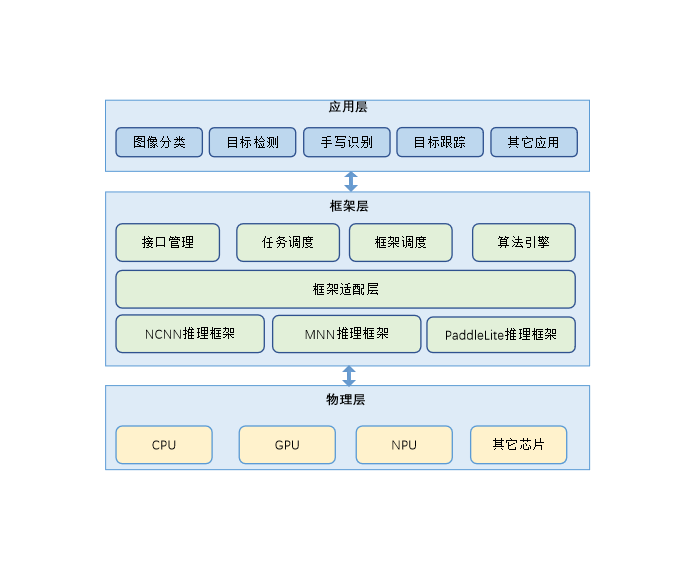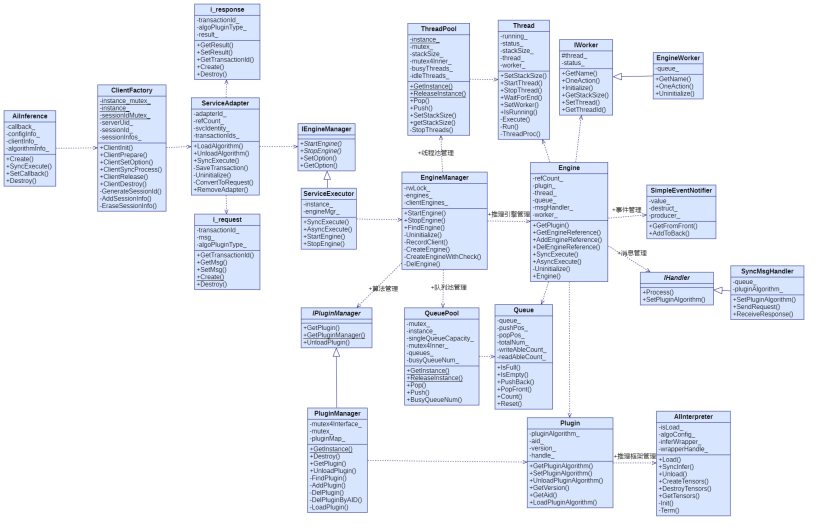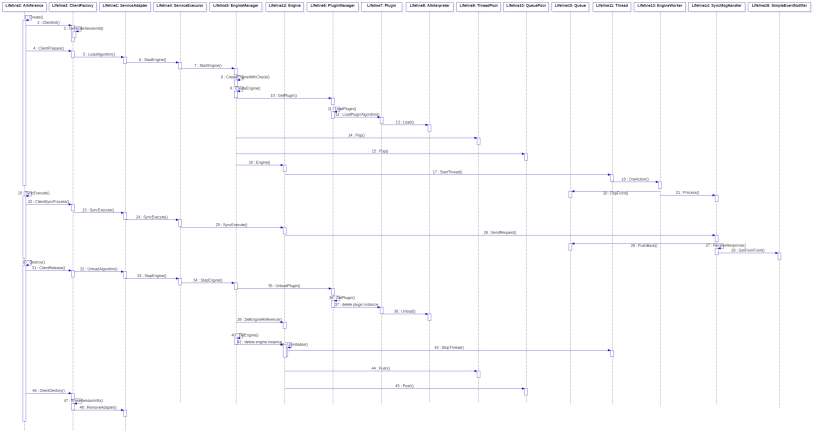
简介
AI推理任务管理与统一推理接口提供了在OpenHarmony标准系统上基于CPU进行AI推理任务调度管理的能力,对AI算法能力进行生命周期管理和按需部署,同时,提供适配不同推理框架层级的统一推理接口,基于NCNN、MNN、Paddlelite三大常用端侧推理框架进行了接口的统一封装。基于统一接口,开发者不需再关心不同推理框架API的差异,可以在各框架之间自如切换,同时,提供了端侧框架的编译脚本,开发者可以直接编译、调用这三个框架,代码仓库地址如下:
- ncnn框架:OpenHarmony-TPC/ncnn (gitee.com)。
- paddle-lite框架:OpenHarmony-TPC/paddle_lite (gitee.com)。
- mnn框架:OpenHarmony-TPC/mnn (gitee.com)。
图 1 AI推理任务管理与统一推理接口架构图:

各模块介绍:
- 任务调度:任务创建、任务分发、任务销毁。
- 框架调度:推理框架加载、卸载。
- 算法引擎:推理算法加载、执行、卸载,推理结果管理。
- 接口管理:对应用层提供统一的框架层接口。
框架适配层:适配不同的第三方推理框架,屏蔽接口差异,为算法引擎提供统一的接口。
目录
./foundation/ai_std
├── interfaces #对外接口定义
├── services
│ ├── client #应用层接口
│ ├── common #公共接口
│ │ ├── platform
│ │ │ ├── dl_operation #dl接口封装
│ │ │ ├── event #事件管理
│ │ │ ├── lock #读写锁管理
│ │ │ ├── os_wrapper #内核接口封装
│ │ │ ├── queuepool #队列池管理
│ │ │ ├── semaphore #信号量管理
│ │ │ ├── threadpool #线程池管理
│ │ │ └── time #时间接口
│ │ ├── protocol
│ │ │ ├── data_channel #推理数据通道管理
│ │ │ ├── retcode_inner #内部返回值定义
│ │ │ └── struct_definition #内部数据结构定义
│ │ └── utils
│ │ ├── constants #内部常量定义
│ │ ├── encdec #数据序列化与反序列化
│ │ ├── file_operation #文件操作接口封装
│ │ ├── inf_cast_impl.h #对象类型转换
│ │ ├── infer_guard.h #堆内存释放管理接口
│ │ ├── infer_macros.h #公共宏定义
│ │ └── log #log接口定义
│ └── server
│ | ├── engine #推理引擎管理
│ | └── plugin_manager #框架调度管理
│ ├── frwkAdapter
│ │ ├── ai_interpreter.cpp #统一推理接口
│ │ └── src
│ │ ├── common #框架适配器公共函数
│ │ ├── mnn #mnn框架适配
│ │ ├── ncnn #ncnn框架适配
│ │ └── paddlelite #paddlelite框架适配
└── test #测试代码
详细设计
图 2 类关系图:

主要类的功能:
- AiInference:对应用层开放的接口create、SyncInfer、Destroy都定义在该类中。
- ClientFactory:客户端工厂类,整合应用数据调用、管理session、管理serviceAdapter对象的创建和销毁。
- ServiceAdapter:推理服务适配器,为推理任务分配clientId,维护客户端与服务端连接ID,创建推理request,由推理response获取推理结果tensor。
- ServiceExecutor:维护推理引擎管理器的创建与销毁。
- EngineManager:管理推理引擎的创建与销毁。
- Engine:推理引擎,推理的主要功能都由它管理。
- PluginManager:管理框架调度器的创建与销毁。
- Plugin:管理第三方框架与推理模型的加载、卸载。
- AIInterpreter:框架适配器接口类,为AI任务调度管理提供统一的接口,屏蔽不同推理框架的差异。
- EngineWorker:推理线程入口函数由该类提供。
- SyncMsgHandler:负责推理请求的发送、推理结果接收。
图 3 AI任务调度管理时序图:

主要流程:
- 推理任务创建流程:首先分配客户端sessionId,服务端分配clientId,由sessionId和clientId组合生成唯一的transactionId,然后根据框架类型和推理网络加载模型、拉起推理线程。
- 执行推理流程:由sessionId和clientId找到上个流程中创建的推理引擎,创建推理request,压入推理线程队列中,等待推理返回的response。
- 推理任务销毁流程:销毁创建流程中申请的资源包括实例化的对象、申请的内存等, 推理线程终止,线程回收,队列回收。
约束
语言限制:C/C++语言。
操作系统限制:OpenHarmony操作系统。
使用
1.实例化类AiInference。
2.调用AiInference的成员函数Create,传入参数frameworkType,推理网络名称,网络模型路径和推理网络版本号(默认值10000001)。各参数说明如下:
- frameworkType:推理框架ID,从如下枚举Framework_type中选取一个推理框架,当前支持AI_FRAMEWORK_ID_NCNN,AI_FRAMEWORK_ID_MNN和AI_FRAMEWORK_ID_PADDLELITE。
- algorithmName:推理的网络名称,如:mobilenetssd,yolov3。
- modelPathInfos:推理网络的模型路径信息,支持网络拓扑结构与权重数据合一和两个数据分开两个文件的场景,对于合一的场景,结构体的成员type取值NET_COMBINED_TYPE,对于两个数据分开文件表示的场景数组modelPathInfos有两个ModelPathInfo元素,两个元素的type字段分别取值NET_TOPO_FILE_TYPE和WEIGHT_FILE_TYPE,path字段为对应的文件路径。ModelPathType为type字段取值枚举,结构体ModelPathInfo为数组modelPathInfos的元素类型。具体使用方法请参考example章节。
- algorithmVersion:推理网络版本号,默认值10000001,当前不关心该参数值。
int32_t Create(int frameworkType, const std::string &algorithmName, std::vector<ModelPathInfo> &modelPathInfos,
long long algorithmVersion=ALGOTYPE_VERSION_DEFAULT);
typedef enum {
AI_FRAMEWORK_ID_INVALID=0, //invalid inference framework
AI_FRAMEWORK_ID_NCNN=1, //ncnn inference framework
AI_FRAMEWORK_ID_MNN=2, //mnn inference framework
AI_FRAMEWORK_ID_PADDLELITE=3, //paddle-lite inference framework
AI_FRAMEWORK_ID_COUNT
}Framework_type;
typedef enum {
NET_COMBINED_TYPE = 0, //topolopy and weight at one model file
NET_TOPO_FILE_TYPE = 1, //file type is neure network inference model topology
WEIGHT_FILE_TYPE = 2, //file type is neure network inference model weight
}ModelPathType;
typedef struct ModelPathInfo {
ModelPathType type; //model file type
std::string path; // model file path regard to file type
}ModelPathInfo;
3.构造推理输入Tensor,调用成员函数SyncExecute执行推理,函数的声明及参数定义如下。输入和输出参数的类型IOTensors定义如下,具体使用方法请参考example章节。
int32_t SyncExecute(const IOTensors &input, IOTensors &output);
using IOTensors = std::vector<IOTensor>;
typedef struct {
std::string name; //network node name
TensorType type; //data type in buffer
TensorLayout layout; //layout of tensor
std::vector<size_t> shape; //shape of tensor for input or output
std::pair<void *, size_t> buffer; //buffer address pointer and size
}IOTensor;
// Tensor type, regard with IOTensor.buffer pointer type
typedef enum {
UINT8 = 0,
INT8 = 1,
UINT16 = 2,
INT16 = 3,
UINT32 = 4,
INT32 = 5,
FLOAT16 = 6,
FLOAT32 = 7,
INT64 = 8,
UINT64 = 9,
}TensorType;
//Tensor layout
typedef enum {
NONE = 0,
NCHW = 1,
NHWC = 2,
NCHWC8 = 3,
ROW_MAJOR = 4,
LSTM_MTK = 5,
HWKC = 6,
HWCK = 7,
KCHW = 8,
CKHW = 9,
KHWC = 10,
CHWK = 11,
NC4HW4 = 12,
}TensorLayout;
```
4.调用成员函数Destroy销毁推理任务。
int32_t Destroy();
example
以下代码片段为使用第三方网络框架NCCN执行网络sequeezenet_v1.1推理的主要部分。
/**
* @brief Set inference input tensor.
*
* @param framework Indicates the inference framework.
* @param inputTensor Indicates the inference input tensor.
* @return Returns {@link AI_RETCODE_SUCCESS} if the operation is successful;
* returns a non-zero error code defined by {@link AiRetCode} otherwise.
*
* @version 1.0
*/
int SetInputTensor(const std::string &framework, IOTensor *inputTensor) {
inputTensor->name = "input";
inputTensor->layout = TensorLayout::NCHW;
int32_t inputSize = 0;
if (framework == "ncnn") {
inputTensor->type = TensorType::FLOAT32;
inputTensor->shape = {1, 3, 227, 227};
inputSize = 227*227*3;
}
int8_t *data = (int8_t *)malloc(inputSize);
if (data == nullptr) {
return AI_RETCODE_NULL_PARAM;
}
memset(data, 1, inputSize);
inputTensor->buffer = std::make_pair((void *)data, inputSize);
return AI_RETCODE_SUCCESS;
}
/**
* @brief Test inference of network squeezenet_v1 in framework ncnn.
*
* @param modelPath Indicates the file path of inference model topo file.
* @param weightPath Indicates the file path of inference model weight file.
* @return Returns {@link AI_RETCODE_SUCCESS} if the operation is successful;
* returns a non-zero error code defined by {@link AiRetCode} otherwise.
*
* @version 1.0
*/
int TestNcnnInfer(const char *modelPath, const char *weightPath)
{
//construct model path param
ModelPathInfo modelPathInfo = {.type = NET_TOPO_FILE_TYPE, .path = modelPath};
ModelPathInfo weightPathInfo = {.type = WEIGHT_FILE_TYPE, .path = weightPath};
std::vector<ModelPathInfo> modelPaths;
modelPaths.emplace_back(modelPathInfo);
modelPaths.emplace_back(weightPathInfo);
//Instance a new inference instantiation
AiInference* pAiInfer = new AiInference();
if (pAiInfer == nullptr) {
return AI_RETCODE_NULL_PARAM;
}
//create a inference engine
int retcode = pAiInfer->Create(AI_FRAMEWORK_ID_NCNN, squeezenet_v1, modelPaths, ncnnVersion);
if (retcode != AI_RETCODE_SUCCESS) {
delete pAiInfer;
return AI_RETCODE_FAILURE;
}
//construct inference input tensors
IOTensor inputTensor;
retcode = SetInputTensor("ncnn", &inputTensor);
if (retcode != AI_RETCODE_SUCCESS) {
delete pAiInfer;
return retcode;
}
IOTensors inputs;
inputs.push_back(inputTensor);
IOTensors outputs;
retcode = pAiInfer->SyncExecute(inputs, outputs);
if (retcode != AI_RETCODE_SUCCESS) {
return AI_RETCODE_FAILURE;
}
//Destroy inference engine
retcode = pAiInfer->Destroy();
if (retcode != AI_RETCODE_SUCCESS) {
LOG_ERROR("inference engine destroy failed, retcode=[%d]\n", retcode);
return AI_RETCODE_FAILURE;
}
DestroyDataInfo(inputs, "input");
DestroyDataInfo(outputs, "output");
return AI_RETCODE_SUCCESS;
}
int main(int argc, char **argv)
{
LOG_INFO("start inference test, para count: %d\n", argc);
int c;
std::string modelPath = "";
std::string weightPaht = "";
std::string framework = "";
int loop_count = 1;
while ((c = getopt_long(argc, argv, short_options, long_options, NULL)) != -1)
{
switch (c)
{
case 'm':
modelPath.assign(optarg);
break;
case 'w':
weightPaht.assign(optarg);
break;
case 'f':
framework.assign(optarg);
break;
case 'l':
loop_count = atoi(optarg);
break;
default:
break;
}
}
int retcode = AI_RETCODE_SUCCESS;
//Different framework use different Model representation
if (strcmp(framework.c_str(), "paddlelite") == 0) {
retcode = TestPaddlelitInfer(modelPath.c_str());
} else if (strcmp(framework.c_str(), "ncnn") == 0) {
retcode = TestNcnnInfer(modelPath.c_str(), weightPaht.c_str());
} else if (strcmp(framework.c_str(), "mnn") == 0) {
retcode = TestMnnInfer(modelPath.c_str());
}
return retcode;
}
总结
本文主要介绍了AI任务调度管理与统一推理框架接口的框架结构、类关系图和时序图,并列出了对应用层开放的接口及使用方法。










































